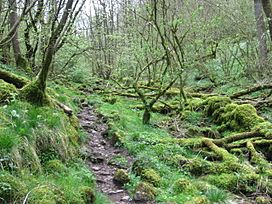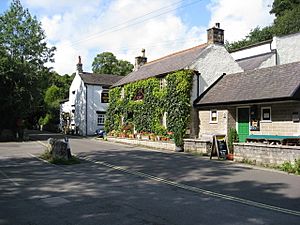Monk's Dale facts for kids
Quick facts for kids Monk's Dale |
|
|---|---|

Monk's Dale Nature Reserve
|
|
| Length | 1.6 miles (3 km) North-South |
| Width | 350 metres (1,148 ft) |
| Depth | 70 metres (230 ft) |
| Geography | |
| Location | Derbyshire, England |
| Rivers | A winterbourne stream |
Monk's Dale is a beautiful, narrow valley in the Peak District of England. It's located near the town of Buxton in Derbyshire. This valley is known as a "dry gorge" because it has very steep sides and often doesn't have a river flowing through it all year.
The dale is surrounded by farmland and sits east of the village of Wormhill. To the north, Monk's Dale connects to Peter Dale. To the south, it meets Miller's Dale.
Contents
A Look at Monk's Dale History
Monk's Dale gets its name from the monks of Lenton Priory. This was a Benedictine monastery, a place where monks lived and worked, located in Nottingham.
Back in the 12th century, the priory was given the right to collect money from a large area of north Derbyshire. This gift came from a person named William Peverel.
Today, you can still find some old carved stones from the 14th century. These stones are what's left of a "grange." A grange was like a farm or outpost owned by the monks, used to manage their lands.
Water in the Valley
Even though Monk's Dale is often called a "dry gorge," it does have a special stream. This is called a winterbourne stream. It means the stream only flows during the colder, wetter months, usually in winter and spring.
During the summer, the stream often dries up. When it does flow, this winterbourne stream eventually joins the River Wye at Miller's Dale.
Nature and Wildlife in Monk's Dale
Monk's Dale is a very important natural area. It is part of the Derbyshire Dales National Nature Reserve. This reserve is managed by Natural England. It includes five different valleys in the White Peak area. These are Lathkill Dale, Cressbrook Dale, Hay Dale, Long Dale, and Monk's Dale itself.
The valley is home to many different plants. You can find ash and elm trees growing here. There are also shrubs like bird cherry and dogwood.
Rare Plants to Spot
Monk's Dale is special because it has some unusual flowers. In the shady parts of the dale, you might spot the dark red helleborine.
The valley also has many native grasses. These include meadow oat and oat grass. You can also find glaucous sedge, cottongrass, knapweed, and upright brome.
Protecting the Valley's Lichens
Monk's Dale is also a designated Site of Special Scientific Interest (SSSI). This means it's a place that is protected because of its special wildlife or geology. It's especially important for the lichens that grow on the shaded, limestone cliffs. Lichens are unique living things that are a mix of fungi and algae.
Exploring Monk's Dale
At the southern end of the valley, in Miller's Dale, there are two historic buildings. These are listed as Grade II buildings, meaning they are important and protected. One is The Anglers Rest pub, which dates back to the 1700s. The other is the Church of St Anne, built in 1879.
Walking along the bottom of Monk's Dale can be a bit tricky. The footpath is rough and challenging for walkers. However, there are other paths nearby that are easier.
Nearby Walking Trails
The Limestone Way is a long-distance footpath. The Pennine Bridleway is another trail for walkers, cyclists, and horse riders. Both of these paths run along the plateau, which is the flat, high ground to the east of Monk's Dale.
The Monsal Trail is a popular bridleway that follows the Wye Valley. It runs at the southern end of Monk's Dale.
How to Get There
It's easiest to get into the deep valley at either end. At the northern end, footpaths from Wormhill village, Peter Dale, and the Limestone Way all meet up.
At the southern end of the dale, there's a large car park. It's located at Miller's Dale station, right on the Monsal Trail. This makes it a good starting point for exploring the area.


